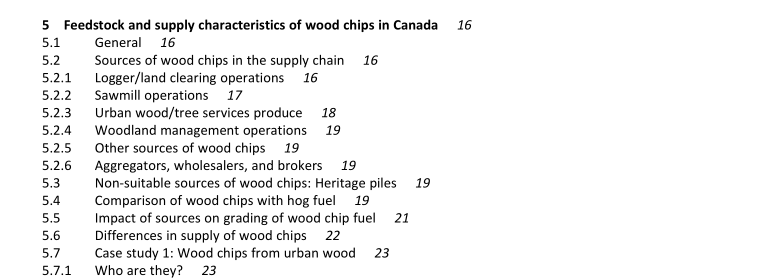CSA SPE 2254:19 pdf download – Guide to wood chip fuel: Characteristics, supply, storage, and procurement.
2 Reference publications This Document refers to the following publications, and where such reference is made, it is to the edition listed below. CSA Group CAN/CSA-ISO 16559:15 Solid biofuels — Terminology, definitions and descriptions CAN/CSA-ISO 17225-4:15 Solid biofuels — Fuel specifications and classes — Part 4: Graded wood chips 3 Definitions The following definitions apply in this Guide and are based on CAN/CSA-ISO 16559. Further details to the descriptions found in the standard are added for clarity. Ash content (A) — mass of inorganic residue remaining after combustion of a fuel under specified conditions; typically expressed as a percentage of the mass of dry matter in fuel. Bark — organic cellular tissue which is formed on the outside of the tree’s growth zone as a shell for the wooden body. Note: Bark is generated as residue in commercial timber harvesting and sawmilling operations. Bulk density — mass of a portion of a solid fuel divided by the volume of the container which is filled by that portion under specific conditions. It is measured in kg/m 3 . Calorific value — energy amount per unit of mass or volume released on complete combustion. Chemically treated wood by-products and residues — chemically treated wood by-products and residues that are treated with wood preservatives or coating but do not contain heavy metals or halogenated organic compounds.
Chemically untreated used wood — residues from debarking, sawing or size reduction, shaping, and pressing processes of used wood that does not contain heavy metals or halogenated organic compounds as a result of its usage and treatment with wood preservatives or coatings and is free of nails, paint, and drywall compounds. Coarse fraction — oversized material, which is outside of the main wood chips fraction after sieving. End users — include project developers, equipment manufacturers, engineering professionals, planning and procurement officers, energy facilities managers, maintenance staff, and those responsible for the operation of wood chips energy systems. Fines fraction — undersize material, which is outside of the main wood chips fraction after sieving. It might contain sawdust and non-combustible material such as soil or sand. Forest, plantation, and other virgin wood — include wood from forests, parks, gardens, plantations, and short rotation forests and coppice; have only been subjected to size reduction, debarking, drying, or wetting. Gross calorific value (GCV)[or high heating value (HHV)] — measured value of specific energy of combustion of a solid fuel burned in oxygen in a bomb calorimeter under such conditions that all the water of the reaction products is in the form of liquid water. It is usually expressed in MJ/kg or GJ/t or BTU/lb. Hog fuel — fuelwood that has pieces of varying size and shape; produced by crushing with blunt tools such as rollers, hammers, or flails. Note: In general usage, hog fuel is a generic term referring to biofuel that might contain many different woody biomass components such as bark, tops, branches, saw dust, and other milling residuals. Logging residues — woody biomass residues created during wood harvesting which include branches and tree tops that can be salvaged when fresh or after seasoning.
4 Wood chips fuel quality standards 4.1 General To encourage the establishment of biofuels markets and reduce the trade barriers between countries, ISO has developed solid biofuels standards based on the existing national standards. The premise of a fuel standard development is to provide clear information on the fuel attributes and quality characteristics, which is necessary for the market to develop. Buyers and users do not think about quality of oil or gas when purchasing, hence, it should not be different for wood fuels. Fuel standards are also necessary tools to strengthen trust in biofuels and bring common language between buyers and sellers. Furthermore, the fuel standards will improve the operation of energy systems allowing the equipment manufacturers to link their equipment guarantees to the use of standardized fuels. CAN/CSA-ISO 17225 Part 4 for graded wood chips is developed for residential, small commercial and public building applications. High and consistent quality wood chip fuels (see Figure 1) are needed for these applications because: a) small scale equipment might not have advanced controls and flue gas cleaning, and the ability to handle oversized and undersized feed material; b) equipment is not managed by professional heating technicians/engineers; and c) equipment can be located in populated areas. CSA SPE 2254:19 pdf download.
